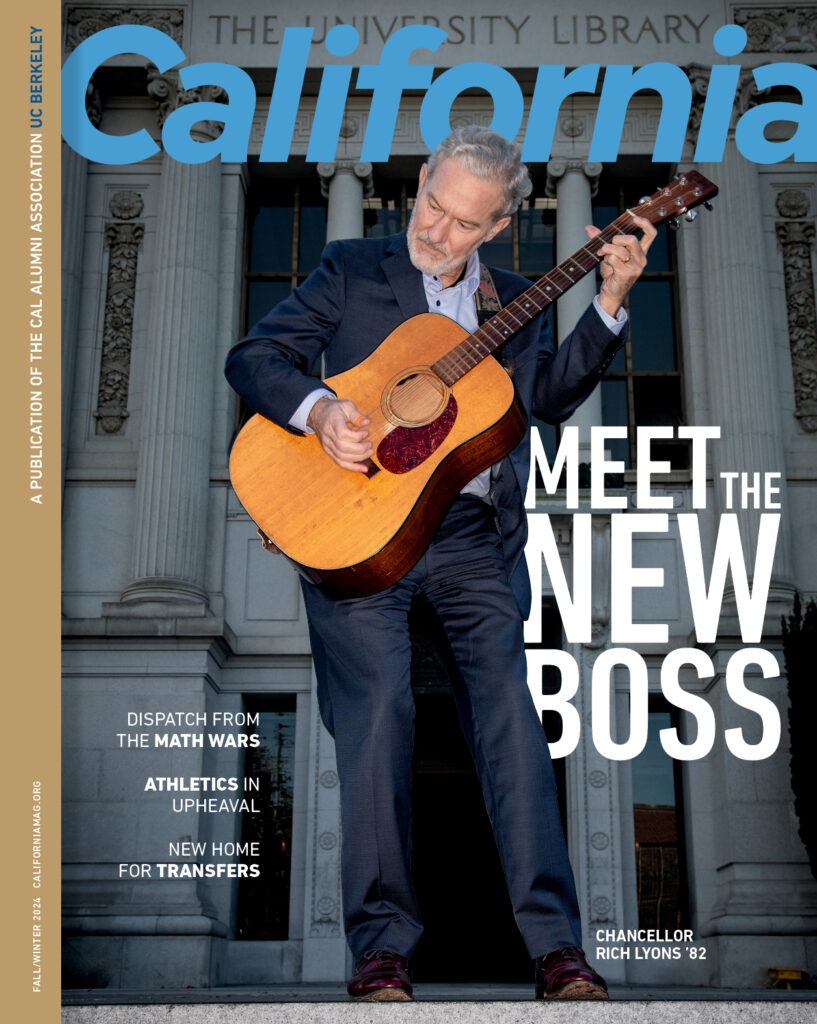On July 7, 2023, a University of California faculty committee unanimously voted to reverse a highly controversial policy. No longer could high school students take Statistics and Data Science as alternatives to Algebra II to satisfy UC admissions requirements. The decision, made by the Board of Admissions and Relations with Schools (BOARS), marked a tide shift in higher education attitudes toward math.
Among the voices who had been critical of the data science courses was Stuart Russell, distinguished professor of computer science at Berkeley. “All the evidence shows that these courses were deliberately designed not to build on or deepen students’ understanding of mathematics,” he wrote in a letter supporting the BOARS decision. “Such a student could certainly not progress in the data science major at Berkeley. The University is therefore in danger of shutting a vast body of students out of careers in science and engineering by authorizing a misleading path to nowhere.”
Russell was not alone in his opinion. Since 2022, hundreds of faculty across California, including many from Berkeley, had signed a letter and a petition saying that the data science courses currently offered in the state were not rigorous enough to qualify as advanced math. Yet, much to their dismay, for years, UC had been quietly allowing students to satisfy their Algebra II admission requirements with these alternative courses.
But the BOARS decision also sparked renewed confusion about long-standing and fundamental disagreements over how to balance equity-focused initiatives and academic rigor when teaching math to high schoolers. Today, many still believe that data science and statistics courses offer more practical and inclusive options for students who may be less mathematically inclined.
At times, the debate over high school algebra has become so heated—and even personal—that it has ignited a new skirmish in the so-called “math wars,” pitting “traditionalists” against “reformists” in a protracted battle that has played out in social media spats, dueling open letters, opinion columns, and even resulted in a threat of police involvement. But while educators, policymakers, and even tech billionaires duked it out everywhere from the Twittersphere to the California State Senate, teachers, parents, and students have been left wondering what it all means for them.
The issue caught fire when, in 2021, the draft of the updated California Mathematics Framework (CMF) came out. Written by experts and adopted by the California State Board of Education, the CMF is designed to help public schools implement the state’s K–12 math standards. While not legally binding, the framework is nevertheless consequential as it sets the tone for how math is taught across the state and even the nation. “On the front page [of textbooks], it’ll say, ‘Follows the guidelines from the California math framework,’” said Sarah Powell, a professor of education at the University of Texas at Austin. “School districts will want to be able to show what they are doing to follow or adhere to the California math framework.” She added, “California is a big state. What happens in California has implications for education across the United States.”
Within months of the CMF draft’s initial release, criticism exploded in the media. In May 2021, the Wall Street Journal published a curious illustration: a bow-tied teacher stands before confused students, pointing at a chalkboard that reads: “2 + 2 may or may not = 4.” The image accompanied an opinion column titled “California Leftists Try to Cancel Math Class,” written by former U.S. Assistant Secretary of Education for Planning, Evaluation, and Policy Development Williamson M. Evers. “The proposed curriculum framework aims low, abandons the gifted, and preaches ‘social justice,’” the column warned.
One thing nearly everyone can agree on: There is a desperate need for math reform in both the state and country. Compared to other industrialized nations, the United States ranks near the bottom in mathematics performance and has been in decline for years. Only 26 percent of U.S. 8th grade students are rated as “proficient” in mathematics, noted Marcia McNutt, president of the National Academy of Sciences, in an article published in the Proceedings of the National Academy of Sciences (PNAS) in September.
The numbers are even more stark for many low-income students of color. In the 2023–2024 school year, 75 percent of low-income Black 11th graders and 66 percent of low-income Hispanic 11th graders failed to meet the state’s math standards, while 52 percent of low-income white 11th graders and 29 percent of Asian 11th graders in the same category fell short of the expected proficiency levels, according to data from the California Assessment of Student Performance and Progress.
Educators have been trying to narrow these achievement gaps for decades, and succeeding would have a far-reaching impact. Research indicates that math performance in K–12 is a predictor of lifetime income—a connection that is expected to intensify as generative AI and machine learning become more dominant components of the economy and demand for STEM graduates grows. At Berkeley, the number of students enrolled in engineering and computer science programs more than doubled from 2012 and 2022.
“We simply are not preparing enough of our high school graduates to pursue STEM careers,” McNutt wrote in her PNAS article. And despite California’s disproportionately high concentration of STEM jobs, the state ranks 38th in math proficiency.
Clearly, improvement was needed. Many feared, however, that the CMF was poised to make things worse. Particularly controversial was an appended tutorial titled A Pathway to Equitable Math Instruction. Many took issue with its framing of modern math education as a tool of oppression and marginalization, what some called “woke math.” The tutorial claimed, for example, that “white supremacy culture infiltrates math classrooms in everyday teacher actions” by treating mistakes as failures rather than opportunities for learning.
The first draft of the CMF referenced the controversial tutorial six times in its 845 pages—sparking enough backlash that it was removed from later versions. By then, however, it was too late; math had become another object of the culture wars.
But it was more than just a lightning rod for the right. Also controversial was the framework’s stance on math curricula, as CMF writers proposed data science—the use of statistics and computational techniques to uncover insights from data—as a more engaging alternative to Algebra II or other third-year high school math courses. The CMF suggested adding real-life scenarios into math problems. Traditional math textbooks, the framework stressed, are often seen as disconnected and “other worldly,” hindering students’ interest and curiosity.
That’s an issue many education experts agree on. Berkeley School of Education Professor Dor Abrahamson, for example, says students perform better when they understand the meaning behind math, rather than just memorizing procedures “as though they’re calculators.”
To that end, more controversially, the CMF writers proposed data science to help students see how math connects to their daily lives.
The backlash was intense. By June 2022, more than 1,700 faculty, researchers, and professionals in quantitative fields—including more than 60 from Berkeley—signed an open letter warning about the “unintended consequences of recent well-intentioned approaches to reform mathematics education.”
“In a math classroom, if the tasks are too simple, there’s no learning. If the class is too challenging, there’s no learning.”
Alan Schoenfeld
In a May 2022 opinion piece in the Los Angeles Times, Jennifer Chayes, dean of Berkeley’s College of Computing, Data Science, and Society, and Tsu-Jae King Liu, dean of Berkeley’s College of Engineering, took issue with the suggestion by the CMF’s authors that, as they paraphrased, “the achievements of computing and wider access to data have made some advanced math courses irrelevant.”
“This rationale is no more valid than saying that grammar- and spell-checking tools have eliminated the need for students to learn how to write,” they insisted. According to Chayes and Liu, “If anything, the pervasiveness of computers means that we should focus more on mathematical reasoning, not less.”
Adding to the confusion is the fact that there are no official standards from UC nor the State of California for what constitutes a high school data science course.
When Stanford mathematician Brian Conrad first heard about the backlash against the CMF, he didn’t think it pertained to math content. But after skimming the document and learning more about the data science pathway, the professor and director of undergraduate studies said he felt a sense of responsibility. In 2022, he spent his spring break poring over the weighty document. “I just sat there all day with my red pen. And I just went through the whole thing, roughly two chapters a day,” he said.
“There would be claims made that to me sounded clearly false or very dubious, at least.” For example, the assertion that neuroscience has shown that the highest achieving people have more interconnected brains. “And so in those cases, I decided to check all of those citations,” he said, adding that some studies had nothing to do with the arguments they were being used to make. “The papers simply sometimes claimed the exact opposite of what was being asserted.” Accusing the CMF of “citation misrepresentation,” a form of academic dishonesty, Conrad created a website to publish his critique.
But even more worrisome to Conrad was that, according to the framework and verified through his additional research, the UC had already approved what Conrad calls “algebra-lite” or “math-lite” data science courses to substitute for Algebra II. Since data science heavily relies on linear algebra and calculus as tools for analyzing large datasets, Conrad thought allowing non-algebra alternatives was “bizarre.” That it was already UC policy alarmed him.
“When I saw that, I almost fell out of my chair. I just couldn’t fathom it,” he said.
How this became UC policy is not entirely clear. The rules for UC admissions are set by a group of faculty members called the Academic Senate, which are then approved by the Board of Regents. Traditionally, students have needed three years of math—Algebra I, Geometry, and Algebra II—to meet these requirements. However, there’s been a long-standing rule in various disciplines that allows advanced courses to replace lower-level ones if they build on previous knowledge. For example, courses like Precalculus are accepted as substitutes for Algebra II because they require prior knowledge of algebra.
But unbeknownst to many UC faculty members, the controversial data science courses were being approved under this rule by the UC Office of the President (UCOP) since at least 2014.
The practice traces back to when AP Statistics was approved as an alternative to Algebra II, a policy that began in the late 1990s, after the College Board administered its first tests on the subject. Because AP Statistics uses some algebra, it was deemed a more advanced course by UCOP. As data science courses were created, starting around 2014, some were quietly approved to be taken in lieu of Algebra II under this guideline because they include some statistics.
Since only a small number of applicants—fewer than 0.2 percent in 2023, for example—opted for the new data science courses instead of Algebra II, the practice went mostly unnoticed for years.
Until it didn’t.
In 2020, the BOARS committee unanimously adopted a proposal to expand math courses, and mentioned data science explicitly. In the spring of 2022, hundreds of academic staff co-signed a petition calling high school Algebra II “an essential prerequisite” and condemning the claim that data science alternatives are “inherently more engaging or more equitable.” Nearly 20 percent of the signatories were Berkeley faculty members, many leaders in data science. Students electing to take a data science course over Algebra II, the letter warned, would likely be closing the door on a future in, well, data science and other STEM careers. “Such students will need remedial math classes in college before they can even begin such majors, putting them at a considerable disadvantage.”
If the only way you know how to deal with data science problems is to use a piece of software, then you’re going to get replaced with a piece of software.
Brian Conrad
On Twitter, things became more personal. Berkeley professor and chair of the computer science division Jelani Nelson took issue that the CMF purported to make math more accessible to Black students, but included no Black authors. “Instead,” he tweeted in March 2022, “one author has alarmingly lucrative consulting deals with school districts with large minority populations, charging $5,000/hr.”
Nelson was referring to Jo Boaler, a professor of mathematics education at the Stanford Graduate School of Education and one of five authors of the CMF. A nationally influential education scholar, Boaler is an endowed chair and has published more than a dozen books. She reached stardom status in education, giving lectures, workshops, and talks worldwide—like her TEDxSaoPauloSalon presentation, “The Challenge of Being a Mathematician as a Woman.”
Critics point out that although she sometimes refers to herself as a mathematician, she is actually a math education professor with no direct affiliation with Stanford’s mathematics department. Her research methods have been scrutinized for nearly two decades, with no shortage of critics claiming they lack rigorous evidence and overstate the applications of neuroscience papers.
In his tweet, Nelson shared a screenshot of a public contract from the predominantly Hispanic Oxnard School District showing that Boaler earned $40,000 for four two-hour sessions of Mathematics Professional Development.
Boaler responded via email. “As a courtesy to a fellow faculty member I wanted to let you know that the sharing of private details about me on social media yesterday is now being taken up by police and lawyers,” she wrote.
Nelson saw the email as a threat—one with racial overtones. He published the email and tweeted: “A @Stanford professor just threatened me with police…Public advisory: don’t call the cops on black people for no reason. Black people disagreeing with you on Twitter is not a crime.”
What followed was typical Twitter drama. Comments and tweets poured in, some of which referred to Boaler as a “Karen.” About a week later, the New York Post ran a story with the inflated headline “Stanford prof calls cops on Berkeley prof who exposed her $5K/hour consulting fee.”
For her part, Boaler has denied threatening to call the police, and noted that while the contract Nelson published denoted instructional time, it omits the preparation time necessary for the course. She believes much of the recent backlash against her is due to critics’ disapproval of the changes proposed in the CMF. Some critics, she said, attempted to discredit her specifically to undermine the framework. “They looked at the set of writers, and I am the one that they see as having influence in education,” she explained, adding that the other four writers aren’t on social media and “don’t have a website that half a million educators go to every month.”
“I’m very happy to have people share different opinions and to have debates about ideas. That’s part of being a scholar. I welcome that,” she said, adding that she draws the line at anonymous threats and “abuse,” which she said increased after Nelson’s posts.
Boaler is also a cofounder of the Stanford research unit YouCubed, which created one of the data science courses that came into controversy during the CMF drafting process.
Berkeley High School teachers Gideon Goldman and Laura Gorrin introduced YouCubed’s class, “Explorations in Data Science,” to offer more options for students struggling with math or looking for something different after noting that, by the second year of math, many students are disengaged by the traditional pathway. A two-year sequence of Data Science and AP Statistics, Goldman said, would “serve a huge number of students much better than forcing them into Calculus.”
But reviews from students were mixed.
One opted for Data Science because it seemed like the easier choice. After “terrible experiences” with his math teachers, he doubted he could handle a more difficult course. YouCubed, he says, “is really a class for people who are trying to skate through school, or are so disinterested in math that they can’t bear to be in a harder math course. Which I would put myself into.”
Another student chose the class for the same reason. In the end, though, he found it too easy. “I didn’t feel like I was really learning anything new or learning to apply old things in new ways.”
This is a common problem. “In a math classroom, if the tasks are too simple, there’s no learning. If the class is too challenging, there’s no learning,” said Alan Schoenfeld, a distinguished professor at the Berkeley Graduate School of Edu-cation. Students learn at different paces, and one of the biggest classroom challenges, he said, is designing tasks with multiple entry points and solutions to engage all levels.
Schoenfeld, an avid supporter of math education reform and outspoken critic of the math wars, thinks “data science versus algebra” is the wrong battle. “I wish it was just a matter of curricula, but it’s not. Yes, the math that students study needs to be rich … and some curricula are clearly richer than others,” he says, but there are other pressing challenges, such as supporting teachers.
In California and the country, Schoenfeld says, most teachers receive minimal training. “You get a bachelor’s degree, you get a year of bootcamp, you’re sent off into a classroom.” In contrast, he says, in Japan, teachers collaborate and observe each other’s classes for over a decade before they are seen as accomplished professionals.
Schoenfeld’s colleague Dor Abrahamson is concerned that many American teachers “may not really understand [a] concept in a very deep way… It’s a bit like learning to recite a poem in a foreign language, where you do it very well, but you just don’t understand the meaning.”
For his part, Stanford’s Conrad worries about the long-term impacts of devaluing fundamental math courses, like Algebra II. Understanding underlying principles, Conrad said, is critical to be able to interpret results and troubleshoot issues. “The way I sometimes say it to students is, if the only way you know how to deal with data science problems is to use a piece of software, then you’re going to get replaced with a piece of software.”
This is a noteworthy example of the California educational system working well and listening to expert feedback in order to best serve its students.
Jennifer Chayes and Jelani Nelson
The CMF is typically revised roughly every eight years, but the latest version took more than two extra years to finalize. Following the delays and criticisms, the new CMF—now substantially different from its original draft—was finally adopted in July 2023. Many of Conrad’s public comments were incorporated, including the removal of the section stating that the high achievers have more interconnected brains. The alternative data science pathway for UC admission was also removed.
Just days before the state board adopted the new math framework, BOARS revoked its longstanding practice of welcoming data science courses as a substitute for Algebra II and created a faculty workgroup to finally define UC’s criteria for advanced math courses, specify the required content to validate Algebra II, and review the three data science courses’ curricula.
The BOARS committee endorsed the workgroup’s first report in February 2024, which restated that only courses that build on what is taught in Algebra II should count as a replacement. Nelson and Chayes praised the decision in an EdSource op-ed: “This is a noteworthy example of the California educational system working well and listening to expert feedback in order to best serve its students,” they wrote. Even tech tycoons like Elon Musk and Sam Altman weighed in, co-signing a letter along with leaders from Apple, Microsoft, and Google praising the UC decision. “Modern AI systems are rooted in mathematics,” they wrote. “We would much rather hire students who have mastered fundamentals than those who have a shallow familiarity with the latest tools or software.”
Meanwhile, many educators still lament a lack of clarity from BOARS. In October 2024, they took their concerns to the California State Assembly, and urged more public hearings and collaboration. Linda Darling-Hammond, president of the California State Board of Education, said during the hearing that the BOARS decision-making process was “very problematic from a K–12 perspective, even though it may feel more orderly from the higher education perspective.” The big logistical issue, she said, is that now other courses need to be reclassified by BOARS, and schools will have little time to adapt to these upcoming decisions.
For the time being, students applying to the UC system will continue to be required to take three years of math, as they have always been. A fourth year of math is recommended, especially for STEM applicants. Starting in 2025, the new rule about data science and statistics no longer satisfying algebra requirements goes into effect.
Going forward, the workgroup encourages future development of third- and fourth-year data science courses that meet UC standards. “The project of creating the new course must start from scratch and will almost certainly take several years to complete,” its June report stated. It will require “enormous creativity, content expertise, and pedagogical experience.” Perhaps this chapter of the math wars, bumpy as it has been, was a necessary step in improving California’s math education. Time will tell.
Schoenfeld, for his part, believes it’s time to move on. Though unsparing in his criticism of the first CMF draft, which he called a “disaster,” he says that ultimately the feedback during the public comment period produced a better document.
“Is it going to win a Pulitzer Prize? Or is it going to win a research prize? No… But the thing that matters is whether the process worked and whether the final outcome is solid. And the answer is yes.”
Nathalia Alcantara is the production editor at California magazine.






















